Decay of timber can take place in three forms; wet rot, dry rot
and woodworm.
Dry Rot is a fungus called Serpula Lacrymans, a type of wood
rot. It is less common than wet rot but it is more
devastating and can spread to and infect parts of the structure
that are relatively dry, attacking timbers several metres from its
source, travelling along masonry and other non-timber objects.
Under ideal conditions it can spread very quickly. Therefore
it is imperative that it is identified correctly and speedily
before it causes too much severe structural damage.
Identifying Dry Rot
To diagnose dry rot, an inspection by a competent surveyor
must be carried out when wood rot is suspected. Our expert
surveyors will carry out a full building survey; a comprehensive
and systematic inspection is essential to ensure that there is no
rot concealed.
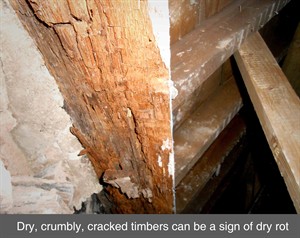 Usually the first and best signs of dry
rot are;
Usually the first and best signs of dry
rot are;
- Red/brown timbers which are crumbly, dry and brittle.
- Rusty red dust; frequently seen around fruiting bodies.
- Growths on the timber which are grey or white strands up to 8mm
thick.
- Silky white cushions of fungus in dark damp areas.
- Thick silvery grey sheets of fungus in less damp conditions.
Patches of yellow and lilac occur if exposed to light.
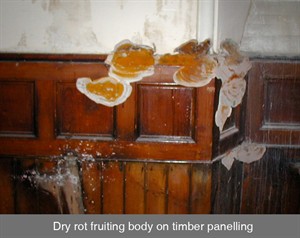
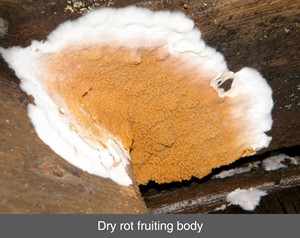
Causes Of Dry Rot
Dry rot fungal spores will easily spread in timbers in the
'right' conditions. That is, timbers subjected to damp
conditions with no ventilation. Dry rot is therefore always
caused by moisture penetrating the building fabric (which can be as
a result of rising
damp or penetrating damp). It is
important that the damp problem is eliminated; otherwise the
problem is likely to re-occur.
Dry rot, as well as being unsightly and creating an odour,
causes the timbers to lose its strength, with the possibility of
structural failure of the timbers in extreme cases.
Dry Rot Treatment
When treating dry rot, the initial priority is to
eliminate the source of damp and promote rapid drying of the
structure. To achieve proper drying can be difficult. Any damp
may be the catalyst for a future outbreak. All
affected timbers need to be removed and replaced. 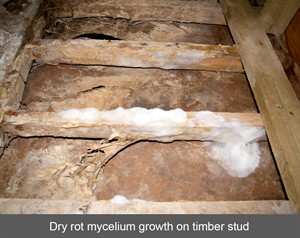
In addition, in order to provide real protection against fungal
decay the timbers should be protected with preservatives, and the
masonry sterilised using products, including:
- Fungicidal masonry treatment
- Deep penetrating timber preservatives: boron
preservative
- Anti-fungicide plasters
- Physical barriers and damp proof materials
Dry Rot Sensors
Where the timbers are large or in hard to reach places, a dry rot
sensor may be used to prevent unnecessary opening up,
especially where decorative elements are in potential dry rot
areas. A sensor is placed in predrilled 7mm holes, at
specific locations, and left for 14 days. The sensor is
checked; a change in colour signifies that dry rot is present. If
there is no change, then the sensors may be left in place for
further monitoring.
Wet Rot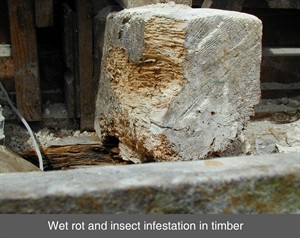
Wet rot is a wood rot, found mainly at the bearings of timber
joists in external walls, for example at the sole or head plates
rather than in the studs. Wet rot decay of timber can take place
only where the wood is maintained in persistently damp
conditions. Wet rot, though problematic, and could
potentially lead to serious issues, is generally not as severe as
dry rot, mainly because it does not spread like dry rot ie wet rot
cannot spread across non-timber surfaces.
Identifying Wet Rot
Wet rot is found in timbers that have been exposed to dampness
for a period of time. Generally, wet rot can be identified by:
- The timbers feeling damp to the touch
- The timbers looking discoloured (usually darkened), may be
cracking, and feel softer, which may lead to the timber losing its
strength
- There may be some fungal growth
- Damp, musty smell
Causes of Wet Rot
Wet rot is caused by the timbers being exposed to a regular
source of moisture; leaking pipe, rising damp or penetrating damp, etc, over a
prolonged period of time. Wet rot, as well as being unsightly
and creating an odour, can cause the timbers to lose its strength,
with the possibility of structural failure of the timbers in
extreme cases.
Wet Rot Treatment
Initially it is imperative that the source of the damp is
stopped. This requires a full building survey by our
experienced surveyors, as it can often be difficult to find.
Once the source of damp has been treated, then the wet and decaying
timbers in the area must be removed and replaced.
Fortunately, unlike dry rot, wet rot does not spread through
masonry, therefore once the affected timbers are removed, then so
too is the wet rot.
Where the timbers are large or in hard to reach places, we
specialise in removing the affected rotted timber, and replacing
only the affected areas, using a technique called Timber-Resin Splice.
Occassionally, the wood rot has caused the timber, often trusses,
to slip and move out of position. Conventionally, the trusses would
be lifted off by crane and repaired on the ground or in a workshop.
Stronghold Preservation have experience in repairing the trusses
insitu, and propping, lifting and jacking the trusses back into
alignment (truss repair &
realignment).
Where there has been evidence of damp in a building, and timber
ends are bearing onto the masonry, we often prefer to treat these
'at risk' timbers with a water soluble boron preservative, to
prolong the life of the timbers.
Our knowledgeable and experienced surveyors can carry out a
survey to identify the type of wood rot, and the cause of the damp,
and provide a comprehensive written report, detailing any remedial
action required. We will also provide a full quotation, where
necessary. Stronghold Preservation offer an insurance backed
guarantee scheme for all remedial timber work.